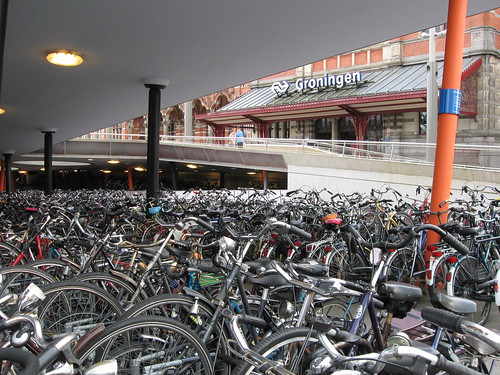Yesterday we had a quick little contest to see how many people could name the city in the western world with the highest percentage of cyclists. The answer was . . .
Groningen, The Netherlands!
A city of only 180,000 people in the northern part of The Netherlands, more than half of all journeys in Groningen are taken by bicycle. In all, 57% percent of inhabitants regularly travel by bicycle compared to only 4 percent in places like the UK.
(Note: It’s entirely possible that Groningen has the highest bicycle usage in the entire world, but given China’s historic lack of public transportation and private automobile ownership we reasoned there’s a good chance a Chinese city would top that list. That’s why we chose to stick purely to the “western world.”)
So why should we care? I think there’s three reasons to care:
ONE. Changing People’s Behaviour Takes A Coordinated Effort.
What’s going on in Groningen is the cumulative affect of work that began in 1977 to move cars out of the city centre. The vast majority of Groningen’s city centre is now entirely car-free (deliveries and emergencies excluded) and is based largely on the concept of filtered permeability. The idea is that cars are gradually filtered out of land use patterns as they converge on a particular area in order to improve the pedestrian realm.
If people in Groningen want to get somewhere quickly they either have to wait (and pay) for a bus or they have to take a bicycle. Furthermore, if the shortest route between two places happens to include a trip through the city centre, a car becomes entirely cumbersome as one would have to drive around the city.
The shift to a car-free downtown helped reinforce and motivate people’s behavioral shift to bicycles.
TWO. Demographics Help Determine Success.
Groningen is an overwhelmingly young city with roughly 1/4 of its entire population attending university there.
What do students overwhelmingly not have a lot of? Money.
What is the most expensive form of urban transportation there is? The car.
Even if students wanted to drive in Groningen, the majority are unlikely to be able to afford to.
While never an explicit part of the strategy, it’s worth contemplating how much the demographic make-up of Groningen allowed the car-free plan to take shape.
A quick thought experiment:
Imagine a town of 180,000 people in North America that was overwhelmingly over-45 office workers. How would that demographic respond to a car-free downtown? Less well than 45,000 Dutch students, I suspect.
Student populations are breeding grounds for new ideas and fashions. Students are in constant communication with one another; tend to be the early adopters of any new trend or technology; are good at influencing the behaviour of their peers; and, vice versa, are highly amenable to adopting the behaviours of their peer group.
It’s quite possible to imagine this cohort (un?)consciously transforming the modest bicycle from an urban necessity to an explicit and clear fashion statement.
It’s important to recognize that change isn’t just about changing people’s behaviour – it’s often about figuring out which group of people’s behaviour is easiest to change and working from there.
THREE. You’ve Never Heard Of Groningen.
Odds are pretty high that most of you have never even heard of Groningen. But then again, most of you had never heard of Medellin either.
Planners, policy-makers and politicians love to trot out the big city examples as proof of what works and what doesn’t. London has their Congestion Charges, New York City has its Broken Windows Theory and Vancouver has (ugh) Vancouverism. It’s good politics to say “Paris does it this way” rather than “Groningen does it this way.” Name recognition obviously matters.
It’s also easier and cheaper to pay attention to the big cities, harder to pay attention to the fringes. But sometimes it’s in those fringe areas where some of the most fascinating things are occurring.
We don’t need more people paying attention to shopworn urban trends from places we’ve heard about a million times. We need people actively searching out and discovering things that work in places we’ve never heard of.
Places like Groningen, for example.


5 Comments
You forgot the most important point : for having a substantial cycle city traffic you got to have a FLAT city.
In Italy’s pianura padana, most of similar Groningen-size cities like Padova (280.000) Ferrara (195000) have an approx. 25% of cycle traffic, this whitout strongly enforced strategies like in Holland.
Its very true that any improvement to cycle traffic (E.G. more cycle only routes, parkings etc) it converts immediately in a shift from cars; the continuous rise in cars operating costs (fuel, insurances etc) are really denting families balance sheets.
in Hill cities cycles are not a mass option, scooters and mopeds is, awaiting for the shift to electric scooters – thats much more realistic than electric cars
That’s a really good point. Topography matters and will always have a dramatic impact on where bicycles will and won’t be accepted en masse.
no reason you couldn’t adjust that idea for topography though
imagine changing a hilly car city to a hilly vespa city … that would be awesome!